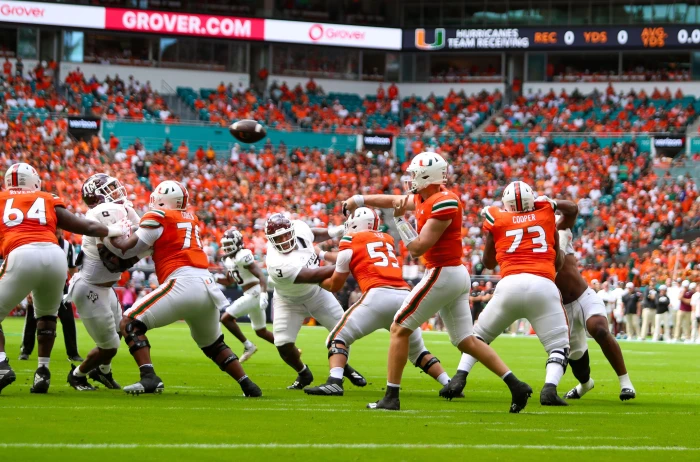
There are significant distinctions in game dynamics, odds, and overall strategy when placing bets on college football as opposed to the NFL. Understanding these differences is crucial for bettors who want to enhance their chances of making informed and profitable wagers.
When it comes to betting, it's apples and oranges between college football and the NFL, from the difference in the number of teams down to how the odds are set. Kknowing what to look for is what separates the winners from the losers.
Volume of Games and Teams
The NCAAF has more than 100 teams divided into numerous conferences, which translates to far more games every week than the NFL with its 32-team league. Where more volume brings more betting possibilities, it also challenges bettors to stay well informed on the variables of the many match-ups.
Talent Disparity
NCAAF teams often feature a wide talent gap, especially when powerhouse programs face smaller schools. These mismatches frequently result in lopsided spreads and high totals, which can create value for those adept at identifying outliers.
NFL games, however, are generally more balanced, as the league is designed to maintain parity. This means tighter spreads and less predictability, requiring bettors to dig deeper into advanced metrics and situational factors.
Betting Markets
College football betting markets tend to be less efficient than NFL markets. Oddsmakers allocate fewer resources to setting college football lines, leading to more exploitable opportunities for savvy bettors. On the other hand, NFL lines are sharpened by massive betting volume and professional gamblers, making it harder to find soft spots.
Emotional and Environmental Factors
Home-field advantage plays a more significant role in NCAAF due to the enthusiasm of college crowds and the lack of travel experience for younger players. Conversely, NFL athletes are accustomed to travel and hostile environments, reducing the impact of home-field dynamics.
Betting Strategies for NCAAF and NFL
NCAAF Betting Strategy
To succeed in college football betting, leverage the following strategies:
- Capitalise on Mismatches: Study team statistics and identify lopsided matchups where strong programs dominate weaker ones. For example, when powerhouse teams like Alabama face underfunded programs, the spreads can be significant. Similarly, analysing games involving mid-tier teams such as Michigan State can yield valuable insights. For example, monitoring Michigan State Spartans odds, especially against evenly matched conference rivals, can reveal opportunities where the spread or totals seem misaligned with actual team potential.
- Focus on Specific Conferences: With so many teams in the NCAAF, it’s wise to specialise in a few conferences. This allows for deeper insights into team dynamics and player performance. If you’re familiar with the Big Ten, for instance, tracking teams like Michigan State provides a focused approach, allowing you to better anticipate line movements and betting value.
- Monitor Line Movements: Early lines in college football can shift significantly as bettors weigh in. Look for discrepancies between opening and closing lines to identify value, especially in games involving notable teams with significant public interest, such as Michigan State Spartans' odds during marquee matchups.
- Account for Motivation: College teams may perform differently based on factors like games between fierce rivals or a battle for bowl eligibility. Understanding the stakes, such as when Michigan State is competing for a pivotal conference victory, can help you assess how motivated a team will be to outperform expectations.
NFL Betting Strategy
Given the NFL's competitiveness, these strategies are vital:
- Analyse Key Metrics: Dive into advanced stats like yards per play, third-down conversion rates, and red-zone efficiency. These indicators often reveal team strengths and weaknesses.
- Bet Against the Public: Public money heavily influences NFL lines, especially on popular teams. Betting against public sentiment can uncover value - but focus and research are essential.
- Consider Situational Factors: Pay attention to travel schedules, rest days, and weather conditions. These factors often impact performance in the tightly contested NFL games.
- Shop for the Best Lines: Small differences in point spreads or moneylines can significantly affect profitability in the NFL. Always compare odds across multiple sportsbooks.
Conclusion
While both college football and the NFL require thorough research and a well-structured plan for successful betting, the differences in key aspects such as team dynamics, market efficiency, and various other factors necessitate distinct approaches. College football bettors can take advantage of mismatches and emotional elements, but it’s essential to concentrate on metrics and situational analysis when betting on the NFL. Long-term success in either league hinges on adopting a strategic approach that respects the unique characteristics of each.
The takeaway? Research and an approach devoid of emotion is paramount. Deal in facts, and don’t fall prey to wishful thinking. Whether you’re betting on your favorite NFL franchise or putting your money where your mouth is by supporting your alma mater, let your head rule your heart.
